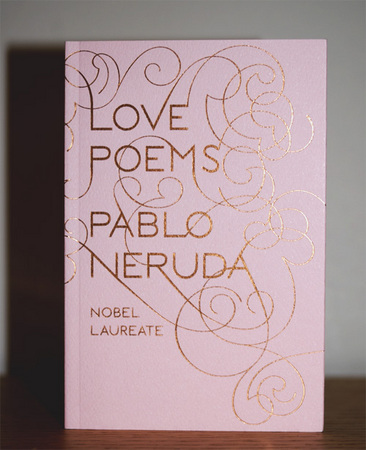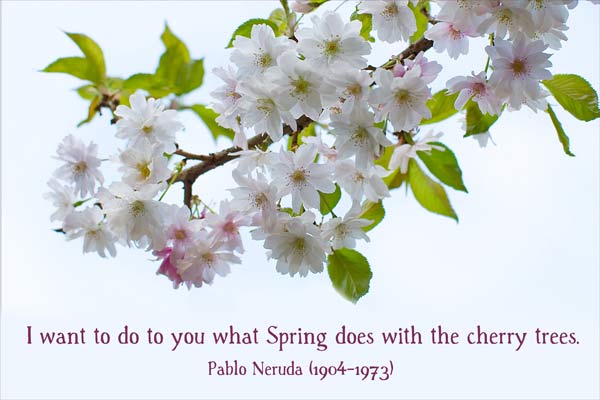Pablo Neruda Love Poems Biography
Source(google.com.pk)No writer of world renown is perhaps so little known to North Americans as Chilean poet Pablo Neruda,” observed New York Times Book Review critic Selden Rodman. Numerous critics have praised Neruda as the greatest poet writing in the Spanish language during his lifetime, although many readers in the United States have found it difficult to disassociate Neruda’s poetry from his fervent commitment to communism. An added difficulty lies in the fact that Neruda’s poetry is very hard to translate; his works available in English represent only a small portion of his total output. Nonetheless, declared John Leonard in the New York Times, Neruda “was, I think, one of the great ones, a Whitman of the South.”
Born Ricardo Eliezer Neftali Reyes y Basoalto, Neruda adopted the pseudonym under which he would become famous while still in his early teens. He grew up in Temuco in the backwoods of southern Chile. Neruda’s literary development received assistance from unexpected sources. Among his teachers “was the poet Gabriela Mistral, who would be a Nobel laureate years before Neruda,” reported Manuel Duran and Margery Safir in Earth Tones: The Poetry of Pablo Neruda. “It is almost inconceivable that two such gifted poets should find each other in such an unlikely spot. Mistral recognized the young Neftali’s talent and encouraged it by giving the boy books and the support he lacked at home.”
By the time he finished high school, Neruda had published in local papers and Santiago magazines, and had won several literary competitions. In 1921 he left southern Chile for Santiago to attend school, with the intention of becoming a French teacher but was an indifferent student. While in Santiago, Neruda completed one of his most critically acclaimed and original works, the cycle of love poems titled Veinte poemas de amor y una canción desesperada—published in English translation as Twenty Love Poems and a Song of Despair. This work quickly marked Neruda as an important Chilean poet.
Veinte poemas also brought the author notoriety due to its explicit celebration of sexuality, and, as Robert Clemens remarked in the Saturday Review, “established him at the outset as a frank, sensuous spokesman for love.” While other Latin American poets of the time used sexually explicit imagery, Neruda was the first to win popular acceptance for his presentation. Mixing memories of his love affairs with memories of the wilderness of southern Chile, he creates a poetic sequence that not only describes a physical liaison, but also evokes the sense of displacement that Neruda felt in leaving the wilderness for the city. “Traditionally,” stated Rene de Costa in The Poetry of Pablo Neruda, “love poetry has equated woman with nature. Neruda took this established mode of comparison and raised it to a cosmic level, making woman into a veritable force of the universe.”
“In Veinte poemas,” reported David P. Gallagher in Modern Latin American Literature, “Neruda journeys across the sea symbolically in search of an ideal port. In 1927, he embarked on a real journey, when he sailed from Buenos Aires for Lisbon, ultimately bound for Rangoon where he had been appointed honorary Chilean consul.” Duran and Safir explained that “Chile had a long tradition, like most Latin American countries, of sending her poets abroad as consuls or even, when they became famous, as ambassadors.” The poet was not really qualified for such a post and was unprepared for the squalor, poverty, and loneliness to which the position would expose him. “Neruda travelled extensively in the Far East over the next few years,” Gallagher continued, “and it was during this period that he wrote his first really splendid book of poems, Residencia en la tierra, a book ultimately published in two parts, in 1933 and 1935.” Neruda added a third part, Tercera residencia, in 1947.
Residencia en la tierra, published in English as Residence on Earth, is widely celebrated as containing “some of Neruda’s most extraordinary and powerful poetry,” according to de Costa. Born of the poet’s feelings of alienation, the work reflects a world which is largely chaotic and senseless, and which—in the first two volumes—offers no hope of understanding. De Costa quoted Spanish poet García Lorca as calling Neruda “a poet closer to death than to philosophy, closer to pain than to insight, closer to blood than to ink. A poet filled with mysterious voices that fortunately he himself does not know how to decipher.” With its emphasis on despair and the lack of adequate answers to mankind’s problems, Residencia en la tierra in some ways foreshadowed the post-World War II philosophy of existentialism. “Neruda himself came to regard it very harshly,” wrote Michael Wood in the New York Review of Books. “It helped people to die rather than to live, he said, and if he had the proper authority to do so he would ban it, and make sure it was never reprinted.”
Residencia en la tierra also marked Neruda’s emergence as an important international poet. By the time the second volume of the collection was published in 1935 the poet was serving as consul in Spain, where “for the first time,” reported Duran and Safir, “he tasted international recognition, at the heart of the Spanish language and tradition. At the same time . . . poets like Rafael Alberti and Miguel Hernandez, who had become closely involved in radical politics and the Communist movement, helped politicize Neruda.” When the Spanish Civil War broke out in 1936, Neruda was among the first to espouse the Republican cause with the poem España en el corazon—a gesture that cost him his consular post. He later served in France and Mexico, where his politics caused less anxiety.
Communism rescued Neruda from the despair he expressed in the first parts of Residencia en la tierra, and led to a change in his approach to poetry. He came to believe “that the work of art and the statement of thought—when these are responsible human actions, rooted in human need—are inseparable from historical and political context,” reported Salvatore Bizzarro in Pablo Neruda: All Poets the Poet. “He argued that there are books which are important at a certain moment in history, but once these books have resolved the problems they deal with they carry in them their own oblivion. Neruda felt that the belief that one could write solely for eternity was romantic posturing.” This new attitude led the poet in new directions; for many years his work, both poetry and prose, advocated an active role in social change rather than simply describing his feelings, as his earlier oeuvre had done.
This significant shift in Neruda’s poetry is recognizable in Tercera residencia, the third and final part of the “Residencia” series. Florence L. Yudin noted in Hispania that the poetry of this volume was overlooked when published and remains neglected due to its overt ideological content. “Viewed as a whole,” Yudin wrote, “Tercera residencia illustrates a fluid coherence of innovation with retrospective, creativity with continuity, that would characterize Neruda’s entire career.” According to de Costa, as quoted by Yudin, “The new posture assumed is that of a radical nonconformist. Terra residencia must, therefore, be considered in this light, from the dual perspective of art and society, poetry and politics.”
“Las Furias y las penas,” the longest poem of Tercera residencia, embodies the influence of both the Spanish Civil War and the works of Spanish Baroque poet Francisco Gomez de Quevedo y Villegas on Neruda. The poem explores the psychic agony of lost love and its accompanying guilt and suffering, conjured in the imagery of savage eroticism, alienation, and loss of self-identity. Neruda’s message, according to Yudin, is that “what makes up life’s narrative (‘cuento’) are single, unconnected events, governed by chance, and meaningless (‘suceden’). Man is out of control, like someone hallucinating one-night stands in sordid places.” Yudin concluded that, “Despite its failed dialectic, ‘Las Furias y las penas’ sustains a haunting beauty in meaning and tone” and “bears the unmistakable signature of Neruda’s originality and achievement.”
While some critics have felt that Neruda’s devotion to Communist dogma was at times extreme, others recognize the important impact his politics had on his poetry. Clayton Eshleman wrote in the introduction to Cesar Vallejo’s Poemas humanos/ Human Poems that “Neruda found in the third book of Residencia the key to becoming the twentieth-century South American poet: the revolutionary stance which always changes with the tides of time.” Gordon Brotherton, in Latin American Poetry: Origins and Presence, expanded on this idea by noting that “Neruda, so prolific, can be lax, a ‘great bad poet’ (to use the phrase Juan Ramon Jimenez used to revenge himself on Neruda). And his change of stance ‘with the tides of time’ may not always be perfectly effected. But . . . his dramatic and rhetorical skills, better his ability to speak out of his circumstances, . . . was consummate. In his best poetry (of which there is much) he speaks on a scale and with an agility unrivaled in Latin America.”
Neruda expanded on his political views in the poem Canto general, which, according to de Costa, is a “lengthy epic on man’s struggle for justice in the New World.” Although Neruda had begun the poem as early as 1935—when he had intended it to be limited in scope only to Chile—he completed some of the work while serving in the Chilean senate as a representative of the Communist Party. However, party leaders recognized that the poet needed time to work on his opus, and granted him a leave of absence in 1947. Later that year, however, Neruda returned to political activism, writing letters in support of striking workers and criticizing Chilean President Videla. Early in 1948 the Chilean Supreme Court issued an order for his arrest, and Neruda finished the Canto general while hiding from Videla’s forces.
“Canto general is the flowering of Neruda’s new political stance,” Don Bogen asserted in the Nation. “For Neruda food and other pleasures are our birthright—not as gifts from the earth or heaven but as the products of human labor.” According to Bogen, Canto general draws its “strength from a commitment to nameless workers—the men of the salt mines, the builders of Macchu Picchu—and the fundamental value of their labor. This is all very Old Left, of course.” Commenting on Canto general in Books Abroad, Jaime Alazraki remarked, “Neruda is not merely chronicling historical events. The poet is always present throughout the book not only because he describes those events, interpreting them according to a definite outlook on history, but also because the epic of the continent intertwines with his own epic.”
Although, as Bizzarro noted, “In [the Canto general], Neruda was to reflect some of the [Communist] party’s basic ideological tenets,” the work itself transcends propaganda. Looking back into American prehistory, the poet examined the land’s rich natural heritage and described the long defeat of the native Americans by the Europeans. Instead of rehashing Marxist dogma, however, he concentrated on elements of people’s lives common to all people at all times. Nancy Willard wrote in Testimony of the Invisible Man, “Neruda makes it clear that our most intense experience of impermanence is not death but our own isolation among the living. . . . If Neruda is intolerant of despair, it is because he wants nothing to sully man’s residence on earth.”
Pablo Neruda Love Poems

Pablo Neruda Love Poems

Pablo Neruda Love Poems

Pablo Neruda Love Poems

Pablo Neruda Love Poems

Pablo Neruda Love Poems

Pablo Neruda Love Poems

Pablo Neruda Love Poems

Pablo Neruda Love Poems

Pablo Neruda Love Poems

No comments:
Post a Comment